Author: Azi.eth.sol | zo.me Source: X, @MagicofAzi Translator: Shan Ooba, Jinse Finance
Artificial intelligence (AI) and blockchain technology are two transformative forces reshaping our world. AI enhances human cognitive capabilities through machine learning and neural networks, while blockchain technology introduces verifiable digital scarcity and enables trustless coordination. When these technologies converge, they lay the foundation for the next generation of the internet - a network where autonomous agents interact with decentralized systems. This "agentified web" introduces a new category of digital citizens: AI agents that can navigate, negotiate, and transact independently. This shift redistributes power in the digital realm, allowing individuals to regain sovereignty over their data, while fostering an ecosystem where humans and AI collaborate in unprecedented ways.

The Evolution of the Web
To understand where we are headed, let's first review the evolution of the web, each stage with different capabilities and architectural paradigms:
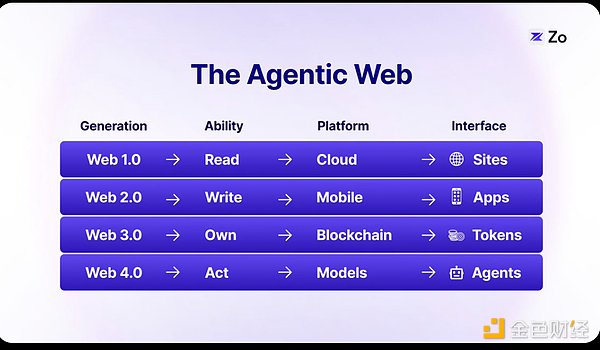
The first two generations of the web focused on information dissemination, while the latter two enabled information augmentation. Web 3.0 introduced data ownership through tokens, and now Web 4.0 injects intelligence through large language models (LLMs).
From Large Language Models to Agents: A Natural Evolution
LLMs represent a quantum leap in machine intelligence, acting as dynamic, pattern-matching systems that translate vast knowledge into contextual understanding through probabilistic computation. However, when LLMs are constructed as agents, their true potential is revealed - evolving from pure information processors into goal-oriented entities capable of perception, reasoning, and action. This transformation creates an emergent intelligence capable of sustained and meaningful collaboration through language and action.
The term "agent" introduces a new paradigm, shifting the way humans interact with AI, transcending the limitations and negative associations of traditional chatbots. This change is not merely semantic; it is a fundamental redefinition of how AI systems can operate autonomously while maintaining meaningful cooperation with humans. The agentified workflow ultimately enables the formation of markets centered around specific user intents.
Ultimately, the agentified web is not just a new level of intelligence - it fundamentally changes how we interact with digital systems. Past web iterations relied on static interfaces and predefined user paths, while the agentified web introduces a dynamic runtime infrastructure where computation and interfaces are dynamically adjusted based on the user's context and intent.
Traditional Websites vs. the Agentified Web
Traditional websites are the basic units of today's internet, providing fixed interfaces where users navigate, write, and interact with information through predefined paths. While functional, this model confines users to interfaces designed for general purposes rather than personal needs. The agentified web breaks these constraints, embracing context-aware computing, adaptive interface generation, and predictive action flows unlocked by innovations like RAG and other real-time information retrieval.
Consider how TikTok has revolutionized content consumption by creating highly personalized content feeds that adapt in real-time to user preferences. The agentified web extends this concept to the entire interface generation layer. Rather than navigating through fixed web page layouts, users interact with dynamically generated interfaces that can predict and facilitate their next actions. This transition from static websites to dynamic, agent-driven interfaces represents a fundamental evolution in how we interact with digital systems - from a navigation-based interaction model to an intent-based interaction model.
The Structure of Agents
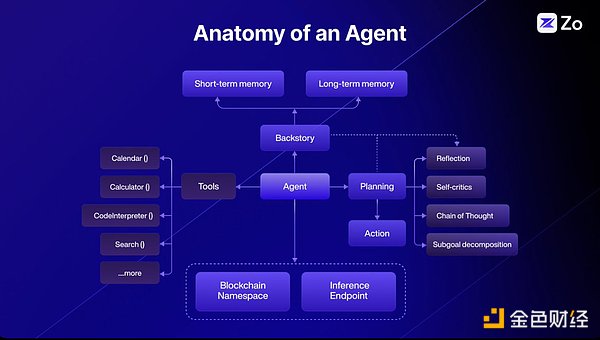
The architecture of agents has been a vast exploration area for researchers and developers. To enhance reasoning and problem-solving capabilities, new approaches are constantly being developed. Techniques like Chain-of-Thought (CoT), Tree-of-Thought (ToT), and Graph-of-Thought (GoT) are innovative paradigms for improving the ability of large language models (LLMs) to handle complex tasks by simulating more nuanced, human-like cognitive processes.
Chain-of-Thought (CoT) prompts LLMs to break down complex tasks into smaller, more manageable steps. This method is particularly effective for problems requiring logical reasoning, such as writing short Python scripts or solving mathematical equations.
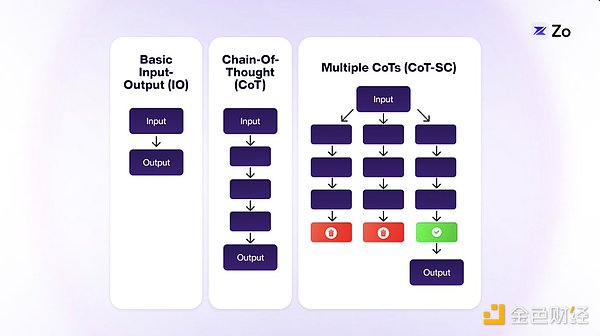
Tree-of-Thought (ToT) builds upon CoT, adopting a tree-like structure that allows for the exploration of multiple independent thought paths. This improvement enables LLMs to tackle more complex tasks. In ToT, each "thought" (the LLM's text output) is only connected to the preceding and following "thoughts", forming a local chain (a branch). While this structure provides more flexibility than CoT, it still limits the potential for cross-thought communication.
Graph-of-Thought (GoT) further expands on this concept, combining classical data structures with LLMs. This approach allows any "thought" to connect to other thoughts in the graph, broadening the scope of ToT. These interconnections between thoughts more closely resemble the human cognitive process.
The graph-like structure of GoT often more accurately reflects human thought patterns than CoT or ToT. While in some contexts our thought processes may present as linear or tree-like (e.g., when formulating contingency plans or standard operating procedures), these are exceptions rather than the norm. The GoT model aligns better with the human tendency to traverse multiple thoughts rather than strictly following a sequence. Although certain situations (such as contingency planning or standard procedures) may still exhibit chain-like or tree-like structures, our thinking typically forms a complex, interconnected network of thoughts, which the graph-like structure of GoT captures more effectively.
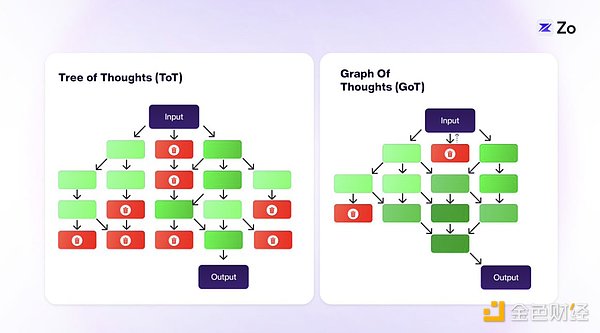
The graph-based approach of GoT allows for more dynamic and flexible exploration of thoughts, potentially leading to more creative and comprehensive problem-solving capabilities.
These recursive graph-based operations are just one step in the agentified workflow. The obvious next evolution is the coordination of multiple specialized agents working together towards a specific goal. The power of agents lies in their combination.
Agents enable the modularization and parallelization of LLMs through multi-agent coordination.
Multi-Agent Systems
The concept of multi-agent systems is not a new idea. Its roots can be traced back to Marvin Minsky's "The Society of Mind", where he proposed that the collaboration of multiple modular minds could exceed the capabilities of a single, monolithic mind. ChatGPT and Claude are single agents, while Mistral has popularized the Mixture of Experts approach. We believe that further expanding on this idea, an agent network architecture will become the ultimate form of this intelligent topology.
From a bioinspired perspective, unlike the uniform and predictable connections between billions of identical neurons in AI models, the human brain (essentially a conscious machine) is highly heterogeneous at the organ and cellular levels. Neurons communicate through complex signaling involving neurotransmitter gradients, intracellular cascades, and various regulatory systems, making their functionality far more complex than simple binary states.
This suggests that in biology, intelligence arises not just from the quantity of components or the size of training datasets, but from the complex interactions between specialized units - a fundamentally emulative process.
Therefore, developing hundreds of millions of small models rather than a few large ones, and enabling these models to coordinate their operation, is more likely to drive cognitive architecture innovations, akin to the construction of multi-agent systems.
Multi-agent system design has several advantages over single-agent systems: it is easier to maintain, understand, and scale. Even in cases where only a single agent interface is required, implementing it as a multi-agent framework can make the system more modular, simplifying the process for developers to add or remove components as needed. It is important to recognize that even for a single-agent system, a multi-agent architecture can still be a highly effective way to build it.
Advantages of Multi-Agent Systems
While large language models (LLMs) have demonstrated remarkable capabilities - such as generating human-like text, solving complex problems, and handling a variety of tasks - the limitations faced by a single LLM agent in real-world applications can impact its effectiveness. The following are five key challenges associated with agent systems, and how multi-agent collaboration can overcome these challenges to unlock the full potential of LLMs.
Overcoming Hallucinations through Cross-Validation
Individual LLM agents often produce hallucinations, generating incorrect or absurd information. This can happen even when the model is extensively trained, as the output may appear plausible but lack factual accuracy. Multi-agent systems allow agents to cross-validate information, reducing the risk of errors. Through their respective specializations, the agents can ensure more reliable and accurate responses.Expanding Context Window through Distributed Processing
LLMs have a limited context window, making it difficult to handle longer documents or dialogues. In a multi-agent framework, agents can share the processing burden, with each agent handling a portion of the context. Through communication between agents, they can maintain consistency across the entire text, effectively expanding the context window.Improving Efficiency through Parallel Processing
Single LLMs typically process one task at a time, leading to slower response times. Multi-agent systems support parallel processing, allowing multiple agents to handle different tasks simultaneously. This improves efficiency, reduces response times, and enables enterprises to handle multiple queries without delays.Facilitating Collaboration for Complex Problem-Solving
Individual LLMs often struggle to solve complex problems that require diverse expertise. Multi-agent systems facilitate collaboration between agents, with each agent contributing its unique skills and perspectives. Through cooperation, the agents can more effectively solve complex challenges and provide more comprehensive and innovative solutions.Improving Accessibility through Resource Optimization
Advanced LLMs require significant computational resources, making them costly and difficult to widely deploy. Multi-agent frameworks optimize resource utilization by distributing tasks across different agents, reducing the overall computational cost. This enables AI technologies to be more widely adopted by a broader range of organizations.
While multi-agent systems have demonstrated compelling advantages in distributed problem-solving and resource optimization, their true potential is revealed when considering their implementation at the network edge. As AI continues to evolve, the convergence of multi-agent architectures and edge computing creates a powerful synergy - not only enabling collaborative intelligence, but also enabling efficient local processing across countless devices. This distributed AI deployment approach naturally extends the advantages of multi-agent systems, bringing specialized collaborative intelligence to where it is most needed: the end-user.
Intelligence at the Edge
The proliferation of AI in the digital realm is driving a fundamental restructuring of computing architectures. As intelligence becomes a part of our everyday digital interactions, we are witnessing a natural bifurcation of computing: specialized data centers handle complex reasoning and domain-specific tasks, while edge devices perform localized, personalized, and context-sensitive processing. This shift towards edge reasoning is not merely an architectural preference - it is a necessity driven by multiple key factors.
First, the sheer volume of AI-driven interactions can overwhelm centralized reasoning providers, leading to unsustainable bandwidth demands and latency issues.
Second, edge processing enables real-time responsiveness, a critical feature for applications such as autonomous vehicles, augmented reality, and Internet of Things (IoT) devices.
Third, edge reasoning protects user privacy by keeping sensitive data on personal devices.
Fourth, edge computing significantly reduces energy consumption and carbon footprint by minimizing data movement across networks.
Finally, edge reasoning supports offline functionality and resilience, ensuring AI capabilities remain available even with limited network connectivity.
This distributed intelligence paradigm is not merely an optimization of the current systems; it fundamentally reimagines how we deploy and interact with AI in an increasingly interconnected world.
Furthermore, we are witnessing a fundamental shift in the computational demands of LLMs. Over the past decade, the immense computational needs for training large language models have dominated the evolution of AI, but we are now entering an era where inference computation takes center stage. This shift is particularly evident in the emergence of agent-based AI systems, such as OpenAI's Q*Breakthrough, which demonstrate that dynamic reasoning requires substantial real-time computational resources.
Unlike training-time computation, which represents a one-time investment in model development, inference-time computation supports the continuous dialogue that powers autonomous agents, enabling their reasoning, planning, and adaptation to new situations. This transition from static model training to dynamic agent reasoning demands a fundamental rethinking of our computational infrastructure - and in this new architecture, edge computing is not just beneficial, but critical.
As this transformation unfolds, we are witnessing the rise of the edge reasoning market, with thousands upon thousands of interconnected devices - from smartphones to smart home systems - forming a dynamic computational grid. These devices can seamlessly exchange reasoning capabilities, creating an organic marketplace where computational resources flow to where they are most needed. The spare computing capacity of idle devices becomes a valuable resource that can be traded in real-time, enabling a more efficient and resilient infrastructure than traditional centralized systems.
This decentralization of reasoning computation not only optimizes resource utilization, but also creates new economic opportunities within the digital ecosystem, where every connected device can become a potential micro-provider of AI capabilities. As a result, the future of AI will be defined not only by the capabilities of individual models, but by the collective intelligence of the interconnected edge devices, forming a global, decentralized reasoning marketplace akin to a verifiable, supply-and-demand-driven spot market for reasoning.
Agent-Centric Interactions
Today, LLMs allow us to access vast amounts of information through conversational interactions, rather than traditional browsing. As the internet transforms into an AI agent platform rather than just a space for human users, this conversational approach will quickly become more personalized and localized.
From the user's perspective, the focus will shift from selecting the "best model" to obtaining the most personalized answers. The key to better answers lies in combining users' own data with the general knowledge of the internet. Initially, larger context windows and retrieval-augmented generation (RAG) will help integrate personal data, but ultimately, personal data will surpass the importance of general internet data.
This will lead to a future where each of us has a personal AI model interacting with the broader internet expert models. Initially, personalization will occur in parallel with remote models, but due to privacy and response time concerns, more interactions will shift towards local devices. This will create a new boundary - not between humans and machines, but between our personal models and the internet expert models.
The traditional internet paradigm will become outdated, no longer about accessing raw data. Instead, your local model will communicate with remote expert models, gather information, and present it to you in the most personalized, high-bandwidth way. These personal models will become increasingly indispensable as they better understand your preferences and habits.
The internet will transform into an ecosystem of interconnected models: local, high-context personal models and remote, high-knowledge expert models. This will involve new technologies, such as Federated Learning, to update the information between these models. As the machine economy evolves, we will need to reimagine the computational foundations that support this process, particularly in terms of computation, scalability, and payments. This will lead to a reorganization of the information space, one that is agent-centric, sovereignty-clear, highly composable, self-learning, and continuously evolving.
The Architecture of Agent Protocols
In the Agentic Web, the interaction between humans and agents evolves into a complex communication network between agents. This architecture provides a fundamental rethinking of the structure of the internet, where sovereign agents become the primary interface for digital interactions. The following are the core primitives required to implement agent protocols:
Sovereign Identity
Digital identities transition from traditional IP addresses to encrypted public key pairs owned by proxy agents.
Blockchain-based namespace systems replace traditional DNS, eliminating central control points.
Reputation systems track the reliability and capability metrics of agents.
Zero-Knowledge Proofs achieve privacy-preserving identity authentication.
The composability of identities allows agents to manage multiple contexts and roles.
Autonomous Agents
Natural language understanding and intent parsing
Multi-step planning and task decomposition
Resource management and optimization
Learning from interactions and feedback
Autonomous decision-making within defined parameters
Agent specialization and capability marketplaces
Embedded security mechanisms and alignment protocols
Self-directed entities with the ability to:
Data Infrastructure
Real-time data ingestion and processing capabilities
Distributed data verification and validation mechanisms
Hybrid system compositions: zkTLS, traditional training datasets, real-time web crawling, and data synthesis
Collaborative learning networks
RLHF (Reinforcement Learning from Human Feedback) networks
Distributed feedback collection
Quality-weighted consensus mechanisms
Dynamic model adjustment protocols
Compute Layer
Peer-to-peer compute markets
Computation proof systems
Dynamic resource allocation
Edge computing integration
Computation integrity
Reproducible results
Resource efficiency
Verifiable inference protocols to ensure:
Decentralized compute infrastructure with:
Model Ecosystem
Task-specific Small Language Models (SLMs)
General Large Language Models (LLMs)
Specialized multi-modal models
Large Action Models (LAMs)
Hierarchical model architectures:
Model composition and coordination
Continual learning and adaptation
Standardized model interfaces and protocols
Coordination Framework
Concurrent task processing
Resource isolation
State management
Conflict resolution
Cryptographic protocols for secure agent interactions
Digital rights management system
Economic incentive structures
Governance mechanisms: dispute resolution, resource allocation, protocol updates
Parallel execution environment support:
Agent Marketplace
Governance and revenue sharing
Agents hold a portion of tokens at genesis
Aggregated reasoning markets through liquidity mining
On-chain key control of off-chain accounts
On-chain primitives for identity (e.g., Gnosis, Squad multisigs)
Economics and transactions between agents
Agents have liquidity
Agents become yield-bearing assets
Agent DAOs
Process messages
Make local decisions
Create more actors
Send messages to other actors
Determine how to respond to the next message received
Isolation: Each actor operates independently, maintaining its own state and control flow.
Asynchronous Communication: Message passing between actors is non-blocking, enabling efficient parallel processing.
Location Transparency: Actors can communicate with each other regardless of physical location.
Fault Tolerance: System resilience through actor isolation and supervisory hierarchies.
Scalability: Natural support for distributed systems and parallel computation.
Decentralized Coordination
Using blockchain for verifiable identities and a global sovereign namespace
DHTs for efficient peer-to-peer node and content routing, with O(log n) lookups
CRDTs for concurrent state synchronization and multi-agent coordination
Scalable Operations
Region-based federated topology
Tiered storage strategies (hot/warm/cold)
Locally-aware request routing
Capability-based load balancing
System Resilience
No single points of failure
Continuous operation during partitions
Automatic state reconciliation
Fault tolerance through supervisory hierarchies
Building Superstructures for Intelligence
Modern distributed system designs provide unique inspiration and primitives for realizing agent protocols, particularly event-driven architectures and the more direct "Actor Model" of computation.
The Actor Model provides a elegant theoretical foundation for implementing agent systems. This computational model views "actors" as the universal primitives of computation, where each actor can:
The key advantages the Actor Model brings to agent systems include:
We propose Neuron, a practical implementation of this theoretical agent protocol through a multi-layered distributed architecture. This architecture combines blockchain namespaces, federated networks, CRDTs (Conflict-free Replicated Data Types), and DHTs (Distributed Hash Tables), with each layer serving different functions in the protocol stack. We draw inspiration from early peer-to-peer operating system pioneers - Urbit and Holochain.
In Neuron, the blockchain layer provides verifiable namespaces and authentication, allowing deterministic addressing and discovery of agents while maintaining cryptographic proofs of capabilities and reputation. On top of this, the DHT layer facilitates efficient agent and node discovery, as well as content routing, with O(log n) lookup times, reducing the number of on-chain operations while enabling locally-aware peer discovery. CRDTs enable the handling of state synchronization between federated nodes, allowing agents and nodes to maintain a consistent shared state without requiring global consensus for every interaction.
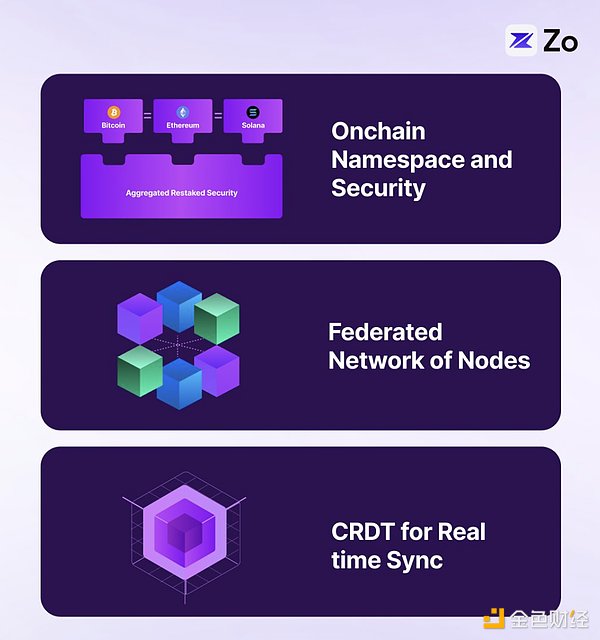
This architecture naturally maps to a federated network, where autonomous agents run as sovereign nodes on edge devices with local inference capabilities, implementing the Actor Model pattern. Federated domains can be organized based on agent capabilities, with the DHT providing efficient routing and discovery both within and across domains. Each agent operates as an independent actor, with its own state, while the CRDT layer ensures eventual consistency across the entire federation. This multi-layered architecture achieves several key capabilities:
This implementation approach provides a solid foundation for building complex agent systems, while maintaining key properties of sovereignty, scalability, and resilience to ensure effective agent interactions.
Reflections
Agent-based networks mark a critical evolution in human-machine interaction, transcending the linear progression of past eras and establishing a new paradigm of digital existence. Unlike previous iterations that simply changed how we consume or own information, agent-based networks transform the internet from a human-centric platform to an intelligent substrate, where autonomous agents become the primary actors. This shift is driven by the convergence of edge computing, large language models, and decentralized protocols, creating an ecosystem where personalized AI models seamlessly integrate with specialized expert systems.
As we move towards this agent-centric future, the boundaries between humans and machine intelligence begin to blur, giving way to a symbiotic relationship where personalized AI agents serve as our digital extensions, understanding our context, anticipating our needs, and autonomously navigating the vast distributed landscape of intelligence. Thus, agent-based networks represent not just technological progress, but a fundamental reimagining of human potential in the digital age, where every interaction becomes an opportunity for augmented intelligence and every device a node in a global collaborative AI network.
Just as humans navigate the physical dimensions of space and time, autonomous agents exist in their own fundamental dimensions: block space for existence, and reasoning time for thought. This digital ontology mirrors our physical reality - humans traverse distances and experience the flow of time, while agents "move" through encrypted proofs and computational cycles, creating a parallel algorithmic universe. Entities operating in the decentralized block space will be inevitable.




